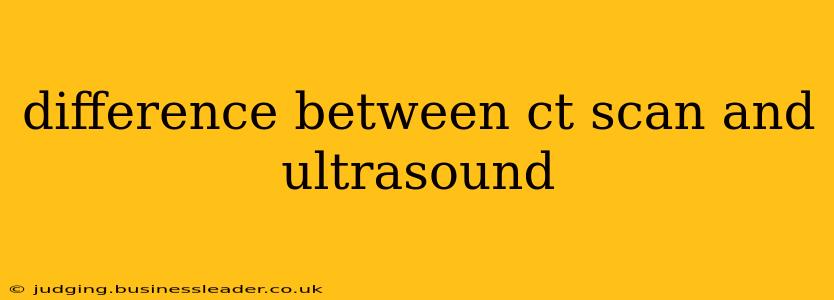CT Scan vs. Ultrasound: Unveiling the Differences
Choosing between a CT scan and an ultrasound depends heavily on the specific medical situation. Both are valuable imaging techniques, but they operate on fundamentally different principles and provide different types of information. This comprehensive guide will explore the key differences, helping you understand when each is most appropriate.
What is a CT Scan?
A Computed Tomography (CT) scan uses X-rays to create detailed cross-sectional images of the body. A sophisticated computer processes these images to construct a 3D representation of the internal structures. CT scans are excellent for visualizing bones, internal organs, and blood vessels. They are often used to detect injuries, tumors, infections, and internal bleeding.
What is an Ultrasound?
An ultrasound, also known as sonography, uses high-frequency sound waves to produce images of internal organs and tissues. A transducer (probe) emits sound waves, and the echoes are processed to create real-time images on a monitor. Ultrasound is a non-invasive technique and doesn't use ionizing radiation.
Key Differences Between CT Scans and Ultrasounds:
Here's a table summarizing the key distinctions:
| Feature | CT Scan | Ultrasound |
|---|---|---|
| Imaging Technique | X-rays | High-frequency sound waves |
| Image Type | Cross-sectional, 3D | Real-time, 2D |
| Radiation | Uses ionizing radiation | Non-ionizing, radiation-free |
| Bone Visualization | Excellent | Poor |
| Soft Tissue Visualization | Good | Excellent, especially for fluid-filled structures |
| Cost | Generally more expensive | Generally less expensive |
| Preparation | May require fasting or contrast dye | Usually no special preparation needed |
| Time | Scan time is relatively short, but overall process can take longer | Scan time is typically shorter |
What are the advantages and disadvantages of each?
CT Scan Advantages:
- Detailed images: Provides highly detailed images of bones and internal organs.
- Wide range of applications: Used for a wide variety of diagnostic purposes.
- Quick scan time: The actual scan time is relatively short.
CT Scan Disadvantages:
- Radiation exposure: Uses ionizing radiation, which carries a small risk of cancer.
- Higher cost: Generally more expensive than ultrasound.
- Contrast dye: May require the use of contrast dye, which can have side effects in some individuals.
Ultrasound Advantages:
- Non-invasive: Doesn't use ionizing radiation, making it safe for pregnant women and children.
- Real-time imaging: Provides real-time images, allowing doctors to observe movement and changes.
- Relatively inexpensive: Generally less expensive than CT scans.
Ultrasound Disadvantages:
- Limited bone visualization: Doesn't provide detailed images of bones.
- Operator-dependent: Image quality depends heavily on the skill of the sonographer.
- Not suitable for all applications: Not suitable for imaging structures obscured by bone or air.
Which imaging technique is better for specific body parts?
The choice between CT and ultrasound depends heavily on the body part being examined and the reason for the imaging. Ultrasound is often preferred for imaging soft tissues like the liver, kidneys, gallbladder, thyroid, and pregnant uterus, while CT scans are better for visualizing bones, lungs, and internal bleeding.
What are the risks associated with each procedure?
CT Scan Risks:
The primary risk associated with CT scans is exposure to ionizing radiation, which can slightly increase the risk of cancer over a lifetime. The risk is generally low for a single scan, but multiple scans increase the cumulative exposure. Allergic reactions to contrast dye are also a possibility.
Ultrasound Risks:
Ultrasound is generally considered a very safe procedure with minimal risks. There are no known long-term side effects associated with exposure to ultrasound waves. However, rarely, some individuals might experience slight discomfort or skin irritation at the probe site.
When would a doctor choose one over the other?
A doctor will choose between a CT scan and an ultrasound based on several factors, including the specific clinical question, the patient's medical history, and the accessibility of the imaging modalities. For example, if a doctor suspects a fracture, a CT scan would be preferred. If they suspect a gallbladder issue, an ultrasound might be the first choice.
This article provides a general overview, and specific clinical decisions should always be made by a healthcare professional based on individual patient needs. Always consult with your doctor to discuss the best imaging approach for your specific situation.
